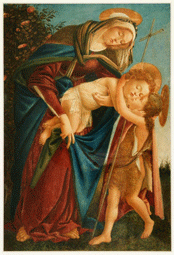'The Virgin and Child with St John' after Botticelli
Charles Fairfax Murray (1849-1919). Watercolour and bodycolour on paper, 1880.
WorkThis work was not the result of a direct commission from Ruskin. Instead, Murray made his copy from the Palatina Gallery, in Florence's Pitti Palace, hoping that Ruskin would later accept it and pay him. Ruskin had, in fact, never seen the original painting and wrote to Murray, 'Your Madonna and roses and little St. John are glorious; but tell me exactly where the picture is and what size? How could I have missed it!' (Works, 37, p. 311).The original painting was made in c. 1490-95 and various copies of it were painted by Botticelli's workshop.The Madonna stoops so that the young St John can greet his baby cousin, an unusual pose for Madonna and infant Christ pictures of the period. The Madonna herself appears more traditionally, wearing red and blue robes, which signify her humanity (red) and spirituality (blue). She stands next to a rose bush. Roses are a symbol of the Madonna and signify her purity. The red colour looks forward towards the blood of Christ's crucifixion.
ArtistCharles Fairfax Murray (1849-1919) made almost 40 copies of Italian masterpieces for the Guild of St George. He was a well-known figure in the late Victorian art world.He began his artistic career by drawing diagrams in a railway engineer's office. In 1866 he became an assistant to Edward Burne-Jones before becoming a designer and painter for the William Morris firm. Ruskin provided Murray with further artistic education and in 1873 sent him to Italy to copy works by Botticelli. After starting a family in Florence, Murray worked in Italy until 1886 when he returned to work in London.In his 'Master's Report: 1884', Ruskin identifies Murray as the 'most skilful' of the artists employed in the task of copying endangered Italian buildings and art. Collection of the Guild of St George, Museums Sheffield
He notes that 'the sketches we possess by his hand, from Carpaccio and Botticelli, are among the principal treasures we can boast at Oxford and Walkley' (Works, 30, p. 72).Despite his skill as a draughtsman, Murray was by the end of his life more famous as an art collector and dealer.
Ruskin on BotticelliRuskin considered Botticelli an artist of 'stupendous power' (Works, 37, p. 138).Botticelli had been trained firstly as a goldsmith and then as a painter under one of Ruskin's favourite artists, Filippo Lippi. Ruskin considered this double training the source of Botticelli's singular capacity for design and the use of colour and light. He also believed that Lippi had given Botticelli at training in 'humility', 'love', 'joy' and 'gentleness' (Works, 22, p. 428).Ruskin's greatest admiration for Botticelli's work stemmed from the artist's knowledge of classical literature and of the works of Dante. He found that Botticelli 'understood the thoughts of Heathens and Christians equally and could in a measure paint both Aphrodite and the Madonna [...] So that he is, on the whole, the most universal of painters; and, take him all in all, the greatest Florentine workman.' (Works, 27, p. 372). The word 'workman' recalls the artist's early training as a goldsmith of which Ruskin so approved. |



















